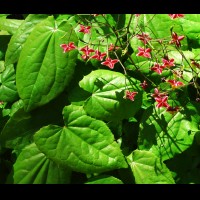E. ×cantabrigiense “Red Form” (Cc. 950018)
A tough, slightly-spreading natural hybrid of E. alpinum, which the deeply veined leaves most closely resemble, and E. pubigerum, which the floral sprays most resemble. One of many plants for which we are grateful to Jerry Flintoff, as Darrell has not found it elsewhere in the U.S. This clone was very common in many of the British gardens we visited in April 1998. The sepals are dark red rather than the pale salmon of the clone commonly cultivated in the U.S. Numeroua, small flowers bloom well above the leaves on loosely branched 18” stems. More vigorous than the U.S. form, with larger, medium-sized leaflets. Semi-evergreen.
A tough, slightly-spreading natural hybrid of E. alpinum, which the deeply veined leaves most closely resemble, and E. pubigerum, which the floral sprays most resemble. One of many plants for which we are grateful to Jerry Flintoff, as Darrell has not found it elsewhere in the U.S. This clone was very common in many of the British gardens we visited in April 1998. The sepals are dark red rather than the pale salmon of the clone commonly cultivated in the U.S. Numeroua, small flowers bloom well above the leaves on loosely branched 18” stems. More vigorous than the U.S. form, with larger, medium-sized leaflets. Semi-evergreen.
